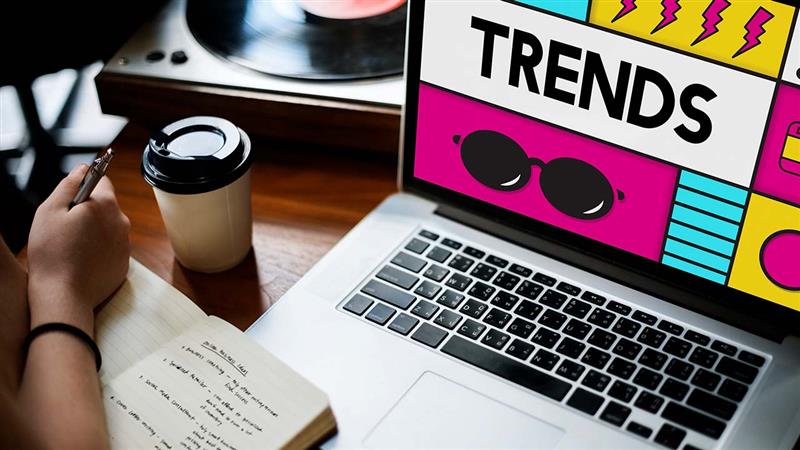Web design is changing more quickly than ever in 2025. Users expect sites that are not just functional but delightful, immersive, and personal. To stay ahead, businesses and designers must adapt. Below is a breakdown of the most important trends to watch and how you can apply them (for instance, to upgrade ) to remain relevant, engaging, and competitive.
1. Dynamic & Personalized UI
One of the biggest shifts is toward dynamic user interface websites that adapt in real time to the user’s behavior, preferences, and context. Rather than showing the same homepage to everyone, elements shift: content, call-to-action, imagery, and layout may adjust depending on who’s visiting. This boosts engagement, time-on-site, and conversions.
How to apply:
Use user segmentation (new vs returning) to dynamically change hero banners or messages. Show recommendations, region-specific content, or contextual help based on user data. Combine with A/B testing to refine what dynamic changes work best.
2. Micro-Interactions & Scroll Animations
Tiny movements, subtle feedback, and scroll-triggered effects are now table stakes. Micro-interactions guide users (hover animations, button ripple effects, progress indicators) and make the interface feel alive.
Scroll-triggered animations allow elements to fade, slide, zoom, or rotate as the user scrolls, turning the page into a storytelling journey.
Tips:
Keep them subtle. Overdoing motion can distract or slow down performance. Use animations to reinforce meaning (e.g., icon rotates to show “refresh”) rather than purely decorative. Mobile test to ensure they remain smooth and don’t hinder usability.
1. 3. Bold, Expressive Typography & Experimental Text
Typography isn’t just about readability anymore, it’s a major brand expression tool. 2025 trends show strong use of bold, oversized, custom, or even animated fonts.
Some designers are intentionally “breaking the rules” with layered, overlapping, or distorted type to create a human, “imperfect” aesthetic. This trend, sometimes called anti-design, embraces asymmetry, raw edges, and experimental layouts.
Pro Tips:
Use variable fonts so you can adjust weight/width dynamically without multiple font files. Always ensure legibility remains high, especially in body copy and on small screens. Reserve experimental typography for headers, hero sections, or visual statements not for long text blocks.
4. Organic & Nature-Inspired Aesthetics
After years of rigid grids and flat minimalism, there’s a growing push toward designs that feel warm, natural, and organic. Think soft curves, irregular shapes, textures, and “natural” color palettes. Squarespace calls this trend Organic Matter.
Squarespace Circle
These organic forms can soften the digital experience and connect users more emotionally to your brand.
Usage ideas:
Background shapes that look hand-drawn or asymmetrical. Subtle textures (paper, fabric, watercolor) behind interface elements. Earthy or muted color schemes rather than overly saturated colors.
Also, learn more about What is UX/CX Design?
5. Vivid Glow, Soft Lighting & Glass / Frosted Effects
To capture attention without overwhelming, designers are embracing glow effects, soft lighting, and translucent/glass-like panels (sometimes called “glassmorphism”).
These effects can give depth, layering, and a futuristic feel to interfaces without relying purely on imagery
How to use:
Use a semi-transparent frosted panel to overlay text on an image or video. Accent key elements (buttons, cards) with a soft glow. Ensure contrast is still sufficient for accessibility; frosted layers should not reduce readability.
6. Sustainable & “Green” Web Design
As the internet's carbon footprint draws more attention, designing sustainable websites is no longer optional; it’s a growing expectation.
This trend pushes for efficient code, lighter images, fewer server requests, greener hosting, and careful consideration of resource usage.
For implementation:
Compress and lazy-load images/videos. Use modern image formats (WebP, AVIF). Clean up unused CSS/JS. Consider hosting providers that use renewable energy or offset carbon.
7. Immersive 3D, AR & WebXR Experiences
Three-dimensional elements, augmented reality (AR), and WebXR (extended reality) are entering more mainstream usage. These immersive visuals let users interact with products, environments, or narratives in new ways.
While these features remain more common for product sites, showrooms, or creative brands, even subtle 3D or depth effects can help modernize a site.
Guidance:
Use lightweight 3D models or WebGL scenes that don’t slow down page load. Offer AR preview for physical products (if applicable) to let users “place” an item in their space. Always provide fallback content for devices or browsers that can't render AR/3D.
8. Navigation Reinvented & Non-Traditional Scrolling
Standard menus and vertical scrolls are being challenged. Expect novel navigation systems (radial menus, hidden toggles, scroll-based navigation) and non-traditional scroll directions (horizontal, diagonal, parallax scroll)
That said, these should be adopted with caution: you don’t want to confuse users. Usability must come first.
When to use:
For portfolio, creative sites, or microsites that allow experimental layouts. Provide clear cues or micro-animations to show how navigation works. Always maintain a fallback to standard navigation for those who prefer it.
9. AI-Driven Tools & Generative Design
Artificial intelligence is creeping deeper into design workflows. From AI-assisted layout suggestions, automatic image generation, to generative videos, AI tools can help speed up ideation and prototyping.
While AI won’t (yet) replace designers, it can assist in doing repetitive tasks or generating variations for review.
Best Practices:
Use AI as a creative assistant, not a full substitute. Curate and refine AI outputs, don’t publish them blindly. Ensure consistency in branding, accessibility, and code quality when integrating AI-generated assets.
10. Minimalism with a Human, Imperfect Touch
Minimalism remains relevant in 2025, but it’s evolving. The “cold minimalism” of years past is giving way to functional minimalism infused with human touches, small imperfections, hand-drawn elements, or subtle asymmetry.
This hybrid approach maintains cleanliness and speed while avoiding a sterile or generic feel.
What to try:
Minimal layout, but with scribbled lines, icons, or illustrative accents. Deliberate spacing or alignment “oddities” to make design feel crafted. Combine minimal page structure with bold typography or color accents for impact. To make your site stand out in 2025, here are practical steps you or your design team can adopt:
Hero Section with Dynamic Personalization
Show different welcoming messages or images based on visitor type (new visitor vs returning). Use a softly glowing call-to-action button overlayed on a semi-transparent glass panel (glassmorphism) to draw attention.
Subtle Animations & Micro-interactions
Add hover effects to buttons, slight movement to icons, scroll-triggered fade-ins for service features. Let your site feel alive without being overbearing.
Expressive Typography for Headlines
Use a bold, custom font for your headers, with contrast against simpler body fonts. Maybe even animate part of the title (e.g. a word morphing or color shift) when the section loads.
Organic Shapes & Natural Accents
Integrate irregular shapes or layered curves in backgrounds behind sections (e.g., team, services). Use nature-inspired texture or muted earthy tones to soften the digital interface.
Performance & Sustainability Optimization
Audit your existing images, scripts, and CSS. Replace heavy assets with optimized formats, adopt lazy-loading, and consider sustainable hosting options to reduce load times and environmental impact.
Fallback 3D / Depth for Products or Team
If you showcase products or designs, use subtle 3D depth, or hover tilt effects. On supported devices, perhaps an interactive 3D model preview.
Navigation Innovation (Cautiously)
If you want to try something fresh, introduce a scroll-based side navigation or a collapsing radial menu on your services page. But always ensure a classic menu fallback.
Use AI Tools for Content & Design Loop
Use AI-powered tools for asset suggestion, color palettes, or layout ideas. But always review each AI suggestion to keep consistency and brand voice.
Key Considerations & Cautions
Mobile first:
Many animations, 3D or custom navigation features may degrade badly on mobile. Always test thoroughly on small screens.
Performance & speed:
No matter how beautiful, a slow website will repel users. Optimize assets, limit heavy JavaScript, and monitor load times.
Accessibility matters:
With all the visuals and effects, never lose sight of accessibility. Good contrast, meaningful alt-text, keyboard navigation, and screen-reader support still matter.
Consistency over novelty:
Don’t adopt every trend at once. Choose a few that align with your brand and use them well.
Fallbacks & graceful degradation: For browsers/devices that can’t support fancy effects, ensure a solid baseline experience.
Final Thoughts
Web design in 2025 is about balance: marrying boldness with usability, immersive experiences with speed, expressive style with performance. The trends above offer exciting ways to make your site distinctive, but success lies in thoughtful application, not simply chasing shiny effects.




